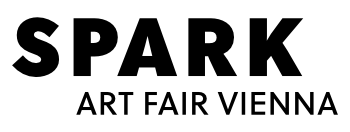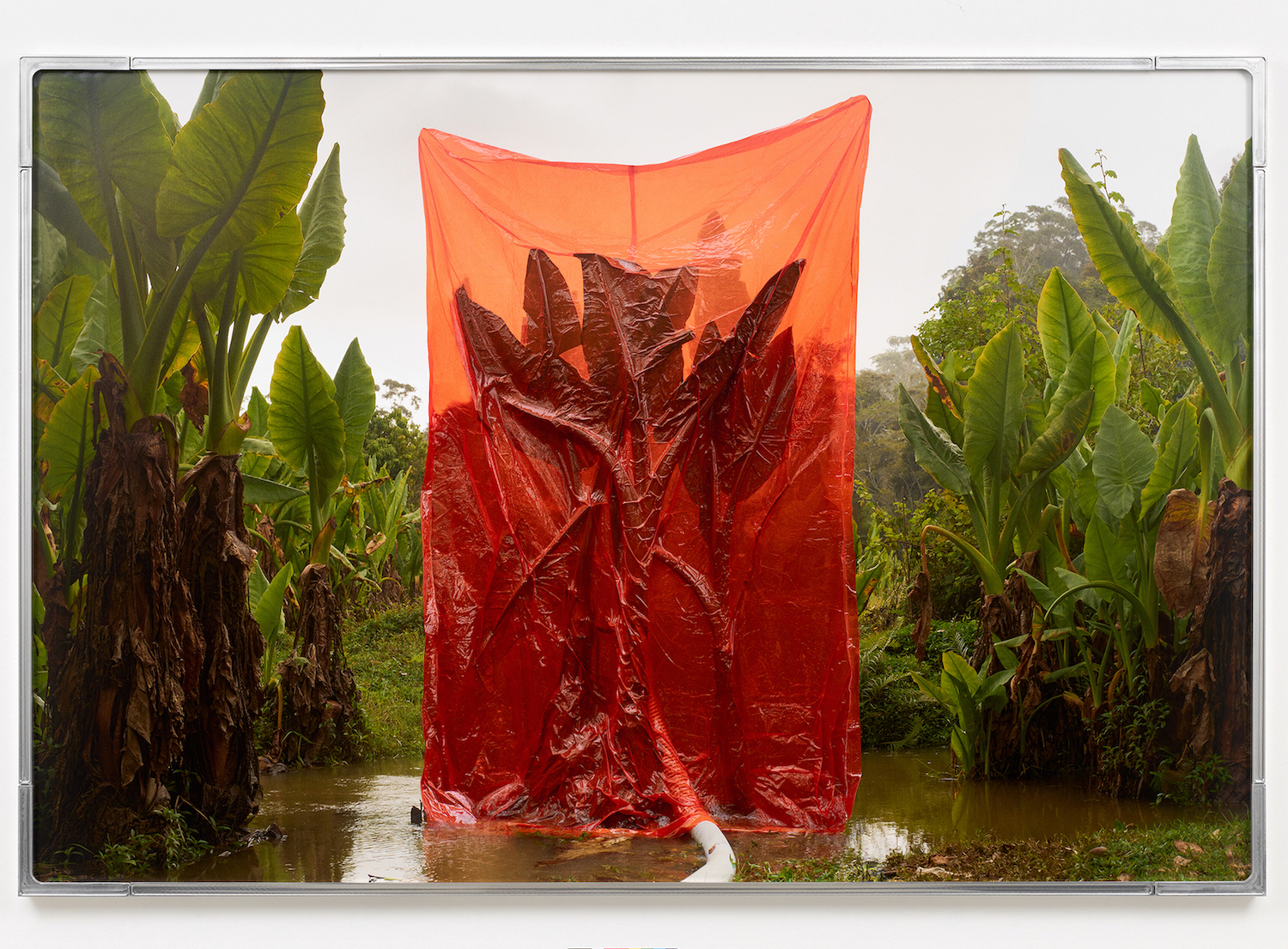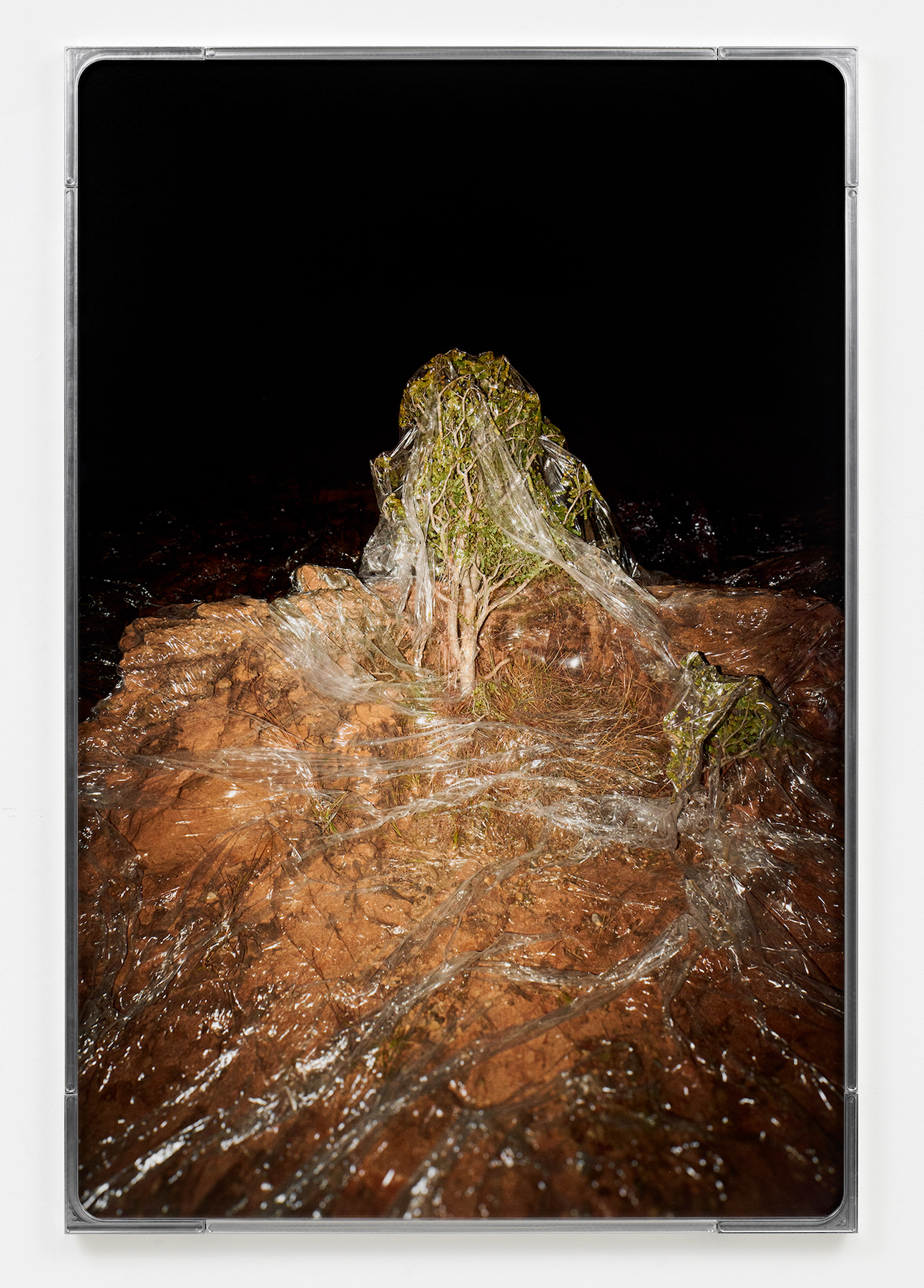alexander levy
We Were All Naked (Red Elephant Ear)
2023
Archival pigment print on Hahnemühle Photo Rag Baryta, machine-milled aluminium frame
147 x 220 cm
© Julius von Bismarck, photography: Tino Kukulies
We Were All Naked (Black Monkey-Thorn)
2023
Archival pigment print on Hahnemühle Photo Rag Baryta, machine-milled aluminium frame
166 x 110 cm
© Julius von Bismarck, photography: Tino Kukulies
Julius von Bismarck
As early as 1985, Donna Haraway described in her essay „A Cyborg Manifesto“ how the fusion of machines and living organisms not only produces hybrids, but also the superimposition of social realities and fiction. Human cyborg existence begins with the first items of clothing. It is the moment of origin when humans began to detach themselves from their own environment. Von Bismarck transfers this moment to plants and stages cyborg landscapes that use the progressive technologisation of our environment as a moment of social reflection.
The machine-milled aluminium frames of the photo series “We Were All Naked” (2023) offer a view of alien worlds as if from a spaceship window. Here, whole areas of land are covered with foil, deprived of the air they need to breathe by a hose. Like a spider’s web, plastic film stretches over stones and small trees, transforming them into an unfamiliar environment. The context of the depopulated scene can hardly be surmised.
In this series produced especially for the exhibition, von Bismarck confronts us with the fact that it is often impossible for non-human beings to adapt quickly enough to the conditions of their environment, changing due to human technologisation. We humans are able to isolate ourselves from our environment, while most other living things perish when they are removed from their ecosystems. The photo series was created in Madagascar, one of earth’s biodiversity hotspots. Analogous to vacuum-packed produce, the artist here wraps living plants in plastic and vacuum-packs them. Indeed, this deprives them of the air they need to breathe. The plants are preserved in their present state and inevitably die. At the same time, the shiny plastic film mirrors our inability to preserve our own environment.
Biography
Julius von Bismarck was born in 1983 in Breisach am Rhein, Germany, and grew up in Riyadh, Saudi Arabia. He currently lives and works in Berlin and Switzerland. He completed his studies at the Universität der Künste Berlin, Hunter College in New York, USA, and the Institute for Spatial Experiments founded by Olafur Eliasson.
By combining visual arts with other fields of research and experimentation, such as natural and social sciences, the results of Julius von Bismarck’s artistic practice can take various forms — from kinetic sculptures and photographs to video installations and landscapes. His works are characterized by the in-depth exploration of phenomena of perception and constructions of reality. The negotiation of nature as a socially constructed fiction is a core focus of his work.
The artist has created numerous solo exhibitions, including at the Berlinische Galerie (2023), Bundeskunsthalle Bonn (2020), and Palais de Tokyo in Paris (2019). Additionally, von Bismarck has participated in various international group exhibitions and bienniales, such as “Abenteuer Abstraktion” at the Sprengel Museum in Hannover (2023), the Mercosul Biennale in Porto Alegre, Brazil (2022), “STUDIO BERLIN” at Berghain in Berlin (2020), “Power to the People” at the Schirn Kunsthalle in Frankfurt/Main (2018), the first Antarctic Biennale (2017), and the Venice Architecture Biennale (Italy) (2012).
In 2008, he was awarded the Prix Ars Electronica and was the first Artist in Residence at CERN, the European Organization for Nuclear Research, in 2012.
alexander levy
The gallery’s focus is on conceptual positions that investigate our perception, reflect on social structures and subversively take up scientific and political themes, all the while expanding on contemporary concept of art discourse. The gallery aims to create a space of presentation for its artists’ and their projects and discourses, which are realised in close cooperation and in constant, intensive exchange. An essential part of the gallery is to enable artists to undertake research-based expeditions and larger projects realised over a long periods of time, and to subsequently present the results in the form of various media in the gallery space, which is often conceptually integrated and subjected to transformation.

+49 30 252 922 21
Lydia Ahrens
+49 30 252 922 21
Julius von Bismarck
As early as 1985, Donna Haraway described in her essay „A Cyborg Manifesto“ how the fusion of machines and living organisms not only produces hybrids, but also the superimposition of social realities and fiction. Human cyborg existence begins with the first items of clothing. It is the moment of origin when humans began to detach themselves from their own environment. Von Bismarck transfers this moment to plants and stages cyborg landscapes that use the progressive technologisation of our environment as a moment of social reflection.
The machine-milled aluminium frames of the photo series “We Were All Naked” (2023) offer a view of alien worlds as if from a spaceship window. Here, whole areas of land are covered with foil, deprived of the air they need to breathe by a hose. Like a spider’s web, plastic film stretches over stones and small trees, transforming them into an unfamiliar environment. The context of the depopulated scene can hardly be surmised.
In this series produced especially for the exhibition, von Bismarck confronts us with the fact that it is often impossible for non-human beings to adapt quickly enough to the conditions of their environment, changing due to human technologisation. We humans are able to isolate ourselves from our environment, while most other living things perish when they are removed from their ecosystems. The photo series was created in Madagascar, one of earth’s biodiversity hotspots. Analogous to vacuum-packed produce, the artist here wraps living plants in plastic and vacuum-packs them. Indeed, this deprives them of the air they need to breathe. The plants are preserved in their present state and inevitably die. At the same time, the shiny plastic film mirrors our inability to preserve our own environment.
Biography
Julius von Bismarck was born in 1983 in Breisach am Rhein, Germany, and grew up in Riyadh, Saudi Arabia. He currently lives and works in Berlin and Switzerland. He completed his studies at the Universität der Künste Berlin, Hunter College in New York, USA, and the Institute for Spatial Experiments founded by Olafur Eliasson.
By combining visual arts with other fields of research and experimentation, such as natural and social sciences, the results of Julius von Bismarck’s artistic practice can take various forms — from kinetic sculptures and photographs to video installations and landscapes. His works are characterized by the in-depth exploration of phenomena of perception and constructions of reality. The negotiation of nature as a socially constructed fiction is a core focus of his work.
The artist has created numerous solo exhibitions, including at the Berlinische Galerie (2023), Bundeskunsthalle Bonn (2020), and Palais de Tokyo in Paris (2019). Additionally, von Bismarck has participated in various international group exhibitions and bienniales, such as “Abenteuer Abstraktion” at the Sprengel Museum in Hannover (2023), the Mercosul Biennale in Porto Alegre, Brazil (2022), “STUDIO BERLIN” at Berghain in Berlin (2020), “Power to the People” at the Schirn Kunsthalle in Frankfurt/Main (2018), the first Antarctic Biennale (2017), and the Venice Architecture Biennale (Italy) (2012).
In 2008, he was awarded the Prix Ars Electronica and was the first Artist in Residence at CERN, the European Organization for Nuclear Research, in 2012.
alexander levy
The gallery’s focus is on conceptual positions that investigate our perception, reflect on social structures and subversively take up scientific and political themes, all the while expanding on contemporary concept of art discourse. The gallery aims to create a space of presentation for its artists’ and their projects and discourses, which are realised in close cooperation and in constant, intensive exchange. An essential part of the gallery is to enable artists to undertake research-based expeditions and larger projects realised over a long periods of time, and to subsequently present the results in the form of various media in the gallery space, which is often conceptually integrated and subjected to transformation.


